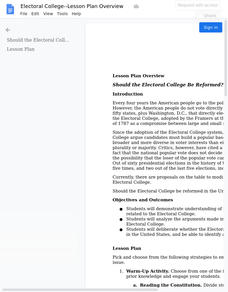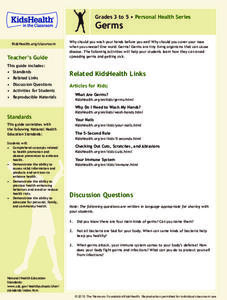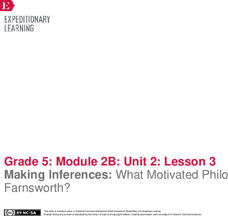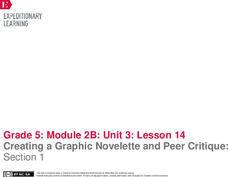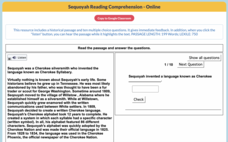Reed Novel Studies
Three Times Lucky: Novel Study
A car crash, a murder, a hurricane. With such a plot, why is the title of Sheila Turnage's novel Three Times Lucky? After making a prediction about the plot, scholars use the novel study to research and record facts about the United...
Ashoka
A Toolkit for Promoting Empathy in Schools
Instill kindness with a unit all about empathy. Lessons and activities follow a prepare, engage, reflect, and action sequence. Learning experiences include making the classroom a safe environment, peer-invented handshakes, discussions...
Nemours KidsHealth
Self-Esteem: Grades 6-8
It would be lovely if we all had mirrors that told us were were fabulous. Alas, such devices designed to boost self-esteem have yet to be invented. However, there are activities that can prove effective. Two activities in a four-page...
C-SPAN
Electoral College
Most people are surprised to learn that American democracy is not as direct as they thought. Using a package of guiding questions, charts and curated videos, learners unpack the unique American institution of the Electoral College. The...
Nemours KidsHealth
Germs: Grades 3-5
Infection prevention is the focus of two lessons. In lesson one, scholars take a brief quiz, survey peers, and discuss prevention techniques to stay healthy. Lesson two examines how germs work—transmission, symptoms, treatments, and...
Education World
Black History 104
Who was the originator of the Blood Bank? What fur and grain trader founded the city of Chicago? Who invented the ironing board and lawn sprinklers? A 10-clue matching activity launches a scavenger hunt for information about famous, yet...
EngageNY
Making Inferences: What Motivated Philo Farnsworth?
Learners continue their work in The Boy Who Invented TV by examining pages 14-17. They work together to determine the gist of the section during a first read then complete a second read to make inferences, create a summary, and define...
EngageNY
Making Inferences: What Motivated Philo Farnsworth?
Turn on the tube. Learners take a look at pages 10-13 of The Boy Who Invented TV. They work in groups and complete a first read to determine the gist of the section. They then reread the pages to make and revise previous inferences and...
EngageNY
The Painted Essay: The Introductory Paragraph
Mimic the model for the perfect essay. Scholars work in groups to analyze a model painted essay The Electric Motor. They compare the structure of the model essay to the painted essay template they created in the previous activity. The...
EngageNY
Creating a Graphic Novelette and Peer Critique: Section 1
Help the class put a plan in place. With the detailed resource, pupils plan the first section of their graphic novelettes about an invention, creating and labeling their pages. Next, they work with partners to give and receive feedback...
EngageNY
Determining Main Ideas and Supporting Details and Summarizing: “Clothing”
Surviving winter. Pupils begin reading on page 18 of The Inuit Thought of It: Amazing Arctic Inventions and sketch how the people used animal skin clothing to survive the winter. Readers complete a main idea graphic organizer with...
Texas Education Agency (TEA)
Production, Distribution, and Other Business Operations
It's all good! Using the informative resource, scholars learn about the difference between goods and services. After researching inventions that have changed lives for the better, partners work together to design a service or product...
Newseum
Fake News Through History: Analyzing Historical Sources
Unfortunately, fake news, fuzzy facts, and bogus news stories are not new phenomena. Class members use a "Fake News Through History" worksheet to analyze historical examples of false, invented, made-up news. Researchers share their...
PBS
Reading Adventure Pack: Music
Music is the focus of the reading adventure pack. After reading, pupils complete hands-on activities. Scholars use household items to make shakers and cymbals. They listen to eclectic music by turning on the radio, borrowing music from...
Mr. Nussbaum
Sequoyah
Test scholars' comprehension with a 10-question interactive. Learners read a short informative text about Sequoyah, a Cherokee silversmith, who invented the language Cherokee Syllabary, then answer fill-in-the-blank and multiple-choice...
PBS
Reading Adventure Pack: Bees
A Reading Adventure pack explores the busy life of bees. After reading a fiction and nonfiction text, scholars complete three hands-on activities. Participants invent a robot that can do the work of bees, cheers to hardworking bees with...
C3 Teachers
Economics of Slavery: How Did Cotton Sow the Seeds of Panic?
An inquiry-based lesson challenges high schoolers to research and identify the economic forces and inventions that impacted the cotton industry. Researchers consider how the use of slavery impacted the economic growth of the United States.
Curated OER
The Microwave and the Jiffy Store
Young historians examine the lifestyle changes and cultural changes that occurred as a result of the challenges posed by World War II on society in general. With regard to American History and culture, pupils write an essay on the...
Teach Engineering
Rube Goldberg and the Meaning of Machines
A Rube Goldberg machine does not really look like it would make work easier. Introduce your class to Rube Goldberg with a resource that shows how his inventions make simple tasks harder to complete.
Curated OER
Exploring the Art of Leonardo da Vinci
Ninth graders use a web worksheet to gather information about the Italian Renaissance artist, Leonardo da Vinci. They look at the front and back of the Mona Lisa, Leonardo's most famous painting. Students learn about the painting...
Teach Engineering
Not So Simple
Compound machines, nothing more than a combination of simple machines working together, are the focus of an activity that asks class members to use the provided information to take a look at the way innovators combine simple machines to...
Curated OER
Kinetic Sculpture
Young scholars discover the art of kinetic sculpture using found materials to create objects with human characteristics. Activities address inventive thinking, utilizing unusual materials and team building through the creation of robotic...
Beacon Learning Center
Growth of a Revolution-The Industrial Revolution
How did changes of the agricultural revolution in eighteenth century Great Britain influence the Industrial Revolution that followed? How were inventions and processes of the Industrial Revolution interrelated? This resource includes a...
Curated OER
Too Bright At Night?
Students explain what causes light pollution and how it can be curtailed. They consider the negative consequences of nighttime lighting, enabled by the invention of electric lights at the close of the 19th Century.
Other popular searches
- Renaissance Inventions
- Civil War Inventions
- Ancient Chinese Inventions
- Inventors and Inventions
- Chinese Inventions
- 19th Century Inventions
- Inventors Inventions
- Innovations and Inventions
- Science Inventions
- Rocket Inventions
- Invention of the Wheel
- Leonardo Da Vinci Inventions





